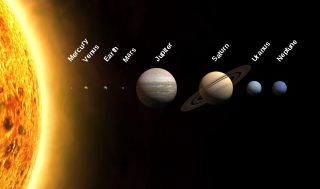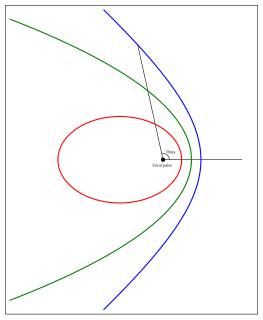
1998 WW31, is a non-resonant trans-Neptunian object and binary system from the Kuiper belt located in the outermost region of the Solar System, approximately 148 kilometers (92 miles) in diameter. It was first observed on 18 November 1998, by American astronomer Marc Buie and Robert Millis at the Kitt Peak National Observatory in Arizona, United States. According to astronomer Michael Brown, the bluish object is "possibly" a dwarf planet. In December 2000, a minor-planet moon, designated S/2000 (1998 WW31) 1 with a diameter of 123 kilometers (76 miles), was discovered in its orbit. After Charon in 1978, it was the first of nearly 100 satellites since discovered in the outer Solar System.
53311 Deucalion ( dew-KAY-lee-ən; from Greek: Δευκαλίων), provisional designation 1999 HU11, is a trans-Neptunian object from the classical Kuiper belt, located in the outermost region of the Solar System, approximately 130–210 kilometers (81–130 miles). The cubewano belongs to the cold population and was discovered on 18 April 1999, by the Deep Ecliptic Survey at the Kitt Peak National Observatory in Arizona, United States. It was named after Deucalion, from Greek mythology.
(15807) 1994 GV9, provisional designation 1994 GV9, is a trans-Neptunian object from the classical Kuiper belt located in the outermost region of the Solar System. The cubewano belongs to the orbitally unexcited cold population. It was discovered on 15 April 1994, by astronomers David Jewitt and Jun Chen at the Mauna Kea Observatories, near Hilo, Hawaii.
(79983) 1999 DF9 is a trans-Neptunian object of the Kuiper belt, classified as a non-resonant cubewano, that measures approximately 270 kilometers in diameter.
(91205) 1998 US43, provisional designation 1998 US43, is a resonant trans-Neptunian object of the plutino group, located in the Kuiper belt in the outermost region of the Solar System. The rather bluish body measures approximately 111 kilometers (69 miles) in diameter. It was discovered on 22 October 1998, by American astronomer Marc Buie at the Kitt Peak National Observatory in the United States. It is probably not a dwarf planet candidate.
(35671) 1998 SN165, provisional designation 1998 SN165, is a trans-Neptunian object from the Kuiper belt located in the outermost region of the Solar System. It was discovered on 23 September 1998, by American astronomer Arianna Gleason at the Kitt Peak National Observatory near Tucson, Arizona. The cold classical Kuiper belt object is a dwarf planet candidate, as it measures approximately 400 kilometers (250 miles) in diameter. It has a grey-blue color and a rotation period of 8.8 hours.
(181902) 1999 RD215 is a trans-Neptunian object of the scattered disc, approximately 148 kilometers in diameter. It was discovered on 6 September 1999, by American astronomers Chad Trujillo, Jane Luu, and David Jewitt at the Mauna Kea Observatories, Hawaii.
2010 KZ39 is a trans-Neptunian object orbiting the Sun as a detached object in the outer reaches of the Solar System. It is likely a dwarf planet as it measures approximately 600 kilometers in diameter. The object was first observed on 21 May 2010, by astronomers Andrzej Udalski, Scott Sheppard, M. Szymanski and Chad Trujillo at the Las Campañas Observatory in Chile.
2010 RF43 is a trans-Neptunian object of the scattered disc orbiting in the outermost regions of the Solar System. It measures approximately 650 kilometers (400 mi) kilometers in diameter and is a strong dwarf-planet candidate. The object was first observed on 9 September 2010, by American astronomers David Rabinowitz, Megan Schwamb and Suzanne Tourtellotte at ESO's La Silla Observatory in northern Chile.
420356 Praamzius, provisional designation 2012 BX85, is a trans-Neptunian object from the classical Kuiper belt, located in the outermost region of the Solar System, approximately 190–320 kilometers (120–200 miles) in diameter. It was discovered on 23 January 2012, by astronomers Kazimieras Černis and Richard Boyle with the Vatican's VATT at Mount Graham Observatory in Arizona, United States. The cold classical Kuiper belt object is a weak dwarf planet candidate and possibly very red in color. It was named after the chief god Praamžius from Lithuanian mythology.
(508869) 2002 VT130 is a trans-Neptunian object and binary system from the cubewano population in the Kuiper belt, located in the outermost region of the Solar System. It was first observed by American astronomer Marc Buie at Kitt Peak Observatory on 7 November 2002. The primary measures approximately 324 kilometers in diameter.

(523794) 2015 RR245, provisional designation 2015 RR245, is a trans-Neptunian object and possible dwarf planet from the Kuiper belt in the outermost regions of the Solar System. It was discovered on 14 September 2010, by Pan-STARRS at Haleakala Observatory on the island of Maui, Hawaii, in the United States. The object stays in a rare 2:9 resonance with Neptune and measures approximately 700 kilometers in diameter, which likely makes it large enough to be round.
(127546) 2002 XU93, provisional designation 2002 XU93, is a trans-Neptunian object and centaur on highly inclined and eccentric orbit in the outer region of the Solar System. It measures approximately 170 kilometers (110 mi) in diameter and is one of few objects with such an unusual orbit. It was discovered on 4 December 2002, by American astronomer Marc Buie at the Kitt Peak National Observatory in Arizona, United States.

2017 OF69 is a resonant trans-Neptunian object from the Kuiper belt, located in the outermost region of the Solar System. The likely dwarf planet belongs to the Kuiper belt's plutino population and measures approximately 533 kilometers (330 miles) in diameter. It was first observed on 26 July 2017, by American astronomers David Tholen, Scott Sheppard, and Chad Trujillo at Mauna Kea Observatories in Hawaii, but not announced until 31 May 2018 due to observations made in April and May 2018 refining its orbit significantly.
2013 FQ28 is a trans-Neptunian object, both considered a scattered and detached object, located in the outermost region of the Solar System. It was first observed on 17 March 2013, by a team of astronomers at the Cerro Tololo Inter-American Observatory in Chile. It orbits the Sun in a moderate inclined, moderate-eccentricity orbit. The weak dwarf planet candidate measures approximately 260 kilometers (160 miles) in diameter.
(523674) 2013 MA12, provisional designation 2013 MA12, is a classical trans-Neptunian object and dwarf planet candidate from the Kuiper belt, located in the outermost region of the Solar System, approximately 340 kilometers (210 miles) in diameter. The cubewano belongs to the hot population. It was discovered on 26 July 2011, by astronomers with the Pan-STARRS survey at Haleakala Observatory, Hawaii, United States.
(523702) 2014 HW199, provisional designation 2014 HW199, is a trans-Neptunian object from the classical Kuiper belt, located in the outermost region of the Solar System. It was discovered on 30 January 2011, by astronomers with the Pan-STARRS survey at Haleakala Observatory, Hawaii, United States. The classical Kuiper belt object is also a dwarf planet candidate, as it measures measures approximately 290 kilometers (180 miles) in diameter.
(523684) 2014 CQ23, provisional designation 2014 CQ23, is a trans-Neptunian object and cubewano from the Kuiper belt, located in the outermost region of the Solar System. It was discovered on 13 March 2011, by astronomers with the Pan-STARRS survey at Haleakala Observatory, Hawaii, United States. The classical Kuiper belt object belongs to the hot population and is a dwarf planet candidate, as it measures approximately 330 kilometers (210 miles) in diameter.
(523687) 2014 DF143, provisional designation 2014 DF143, is a trans-Neptunian object and cubewano from the Kuiper belt, located in the outermost region of the Solar System. It was discovered on 13 March 2011, by astronomers with the Pan-STARRS survey at Haleakala Observatory, Hawaii, United States. The classical Kuiper belt object belongs to the hot population and is a dwarf planet candidate, as it measures approximately 350 kilometers (220 miles) in diameter.
(505624) 2014 GU53, provisional designation 2014 GU53, is a trans-Neptunian object and cubewano from the Kuiper belt, located in the outermost region of the Solar System. It was discovered on 8 April 2014, by astronomers with the Pan-STARRS survey at Haleakala Observatory, Hawaii, United States. The classical Kuiper belt object belongs to the hot population and is a dwarf planet candidate, as it measures approximately 330 kilometers (210 miles) in diameter.











